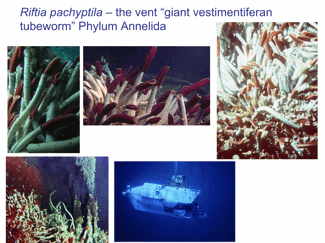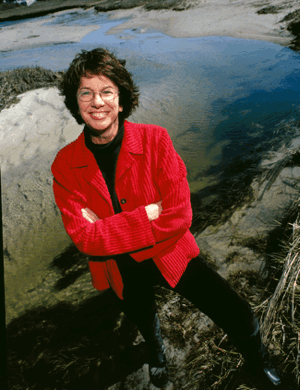Oceanic Give and Take
Air Date: Week of February 12, 2010

(Courtesy of Colleen Cavanaugh)
A boring lecture and journeys to the bottom of the sea gave Harvard University biologist Colleen Cavanaugh fresh insight on how creatures help each survive and thrive. Ari Daniel Shapiro has our story.
Transcript
YOUNG: Well, the natural world still has a lot of surprises. That’s certainly true when we look at symbiosis – the often mutually beneficial relationships between some species.
About a century ago, a young British naturalist named Beatrix Potter – yes, that Beatrix Potter – first proposed that lichens are examples of symbiosis. Her idea was dismissed at the time, but she was right. And the study of symbiosis continues to reveal all sorts of discoveries in some of the most unexpected places. Here’s one not from the past, but from the depths. Reporter Ari Daniel Shapiro has our story.
SHAPIRO: For 30 years, scientists have traveled to the very bottom of the ocean thanks to Alvin, an underwater vehicle.
CAVANAUGH: Yes, Alvin is, I always say it’s the submarine, not the chipmunk.
SHAPIRO: Colleen Cavanaugh is a biology professor at Harvard University, and she’s spied on the seafloor from inside Alvin a number of times.
[CAVANAUGH GIVING DIRECTIONS INSIDE SUB:
Alvin audio, recorded June 3, 1992, courtesy of Professor Colleen Cavanaugh]

Harvard biology professor Colleen Cavanaugh. (Photo: Jim Harrison)
CAVANAUGH: It’s a so-called manned, which I call it a womanned submersible. It has a pilot and carries two scientific observers.
SHAPIRO: And it’s tiny. The space where you actually sit, there’s barely enough room to stretch your arms out to the sides. Tiny portholes let you look out. Not that there’s that much to see.
CAVANAUGH: Most of the deep sea just looks like sediment or black rock, you know, very, very few organisms.
SHAPIRO: But the story’s different at places called hydrothermal vents. Basically, they’re hot springs on the ocean floor. It’s where two plates at the bottom of the ocean are being pushed apart as magma comes up. The magma’s hot and acidic and has all kinds of chemicals in it like sulfur. And, says Cavanaugh, it’s stunning when you’re in Alvin and you approach a hydrothermal vent.
CAVANAUGH: And you start way out, you start to see a crab here, and a crab there, and then, you know, maybe a fish goes by. And as you get closer and closer, there is more and more life. When you actually come up to them, it’s an oasis. It’s biomass that rivals a rainforest.

Alvin manipulates sensors to determine the geochemical environment around this Riftia pachyptila clump. (Courtesy of Colleen Cavanaugh)
SHAPIRO: When these hydrothermal vents were discovered, they completely blew open the view of the deep ocean as an empty, lifeless desert. There was tons of life down there. Thickets of it. One of the creatures in this deep-sea rainforest is something called Riftia.
CAVANAUGH: A Riftia is… well, they’re so called giant tubeworms. They get up to two meters in length.
SHAPIRO: So imagine a long, white tube as tall as your refrigerator and as wide as a roll of quarters.
CAVANAUGH: And the part that you see that’s so astonishing is that they have these brilliant red plumes.
SHAPIRO: Like a pair of wide, ruby lips at the end of this white tube.
CAVANAUGH: And this is effectively their gill, or their lung. It’s the equivalent of our lung. The red that you see is actually due to hemoglobin. So just like we have hemoglobin that carries our oxygen, so do these worms. And this hemoglobin is unique in that it binds both oxygen, like us, but it also binds sulfide in a separate spot.
SHAPIRO: Strange enough yet? A worm at the bottom of the ocean as tall as your fridge that’s got hemoglobin just like we do. And here’s the really weird part about Riftia.
CAVANAUGH: As an adult, it’s completely mouthless and gutless.
SHAPIRO: That’s right. Riftia worms have no mouth, no anus, no gut, and they stay put. So how do these things eat? No one knew. Until Cavanaugh had a kind of epiphany almost 30 years ago.
CAVANAUGH: It was a moment, but it took a while to prove.

(Courtesy of Colleen Cavanaugh)
SHAPIRO: She was sitting through this talk during graduate school that wasn’t what you’d call riveting…
CAVANAUGH: So unbelievably, I was still awake, when I jumped up and said, it’s perfectly clear. They’re effectively like plants but using sulfur instead of sunlight. I mean they must have sulfur-oxidizing chemosynthetic bacteria.
SHAPIRO: Cavanaugh’s revolutionary idea was that a special kind of bacteria lives inside the Riftia worms and actually feeds them. The bacteria use the energy from all the sulfur billowing about the hydrothermal vents to make food – carbohydrates and proteins – for themselves and for the worms.
But this is a two-way street. The Rifita use their hemoglobin to bring the sulfur right to the bacteria’s doorstep. And the worms also give the bacteria a place to live.
CAVANAUGH: Yes, so they’re providing a home, a, in quotes, a warm, cozy environment. Neither the animals nor the bacteria could survive without the other.
SHAPIRO: And it turns out that this discovery opened scientists’ eyes to the fact that this kind of symbiosis, the kind involving inorganic chemicals like sulfur, is happening everywhere. Not just at the deep-sea vents. But also in shallow coastal places // and maybe even on other planets. All these critters, helping each other make a go of it in the universe. And all we had to do was take a lesson from a worm at the bottom of the ocean. For Living on Earth, I’m Ari Daniel Shapiro.
YOUNG: Well for photos and to hear more stories like this one about marine organisms, check out the podcast of the Encyclopedia of Life. You’ll find a link on our website: l-o-e dot org.
Links
Living on Earth wants to hear from you!
Living on Earth
62 Calef Highway, Suite 212
Lee, NH 03861
Telephone: 617-287-4121
E-mail: comments@loe.org
Newsletter [Click here]
Donate to Living on Earth!
Living on Earth is an independent media program and relies entirely on contributions from listeners and institutions supporting public service. Please donate now to preserve an independent environmental voice.
NewsletterLiving on Earth offers a weekly delivery of the show's rundown to your mailbox. Sign up for our newsletter today!
 Sailors For The Sea: Be the change you want to sea.
Sailors For The Sea: Be the change you want to sea.
 The Grantham Foundation for the Protection of the Environment: Committed to protecting and improving the health of the global environment.
The Grantham Foundation for the Protection of the Environment: Committed to protecting and improving the health of the global environment.
 Contribute to Living on Earth and receive, as our gift to you, an archival print of one of Mark Seth Lender's extraordinary wildlife photographs. Follow the link to see Mark's current collection of photographs.
Contribute to Living on Earth and receive, as our gift to you, an archival print of one of Mark Seth Lender's extraordinary wildlife photographs. Follow the link to see Mark's current collection of photographs.
 Buy a signed copy of Mark Seth Lender's book Smeagull the Seagull & support Living on Earth
Buy a signed copy of Mark Seth Lender's book Smeagull the Seagull & support Living on Earth

